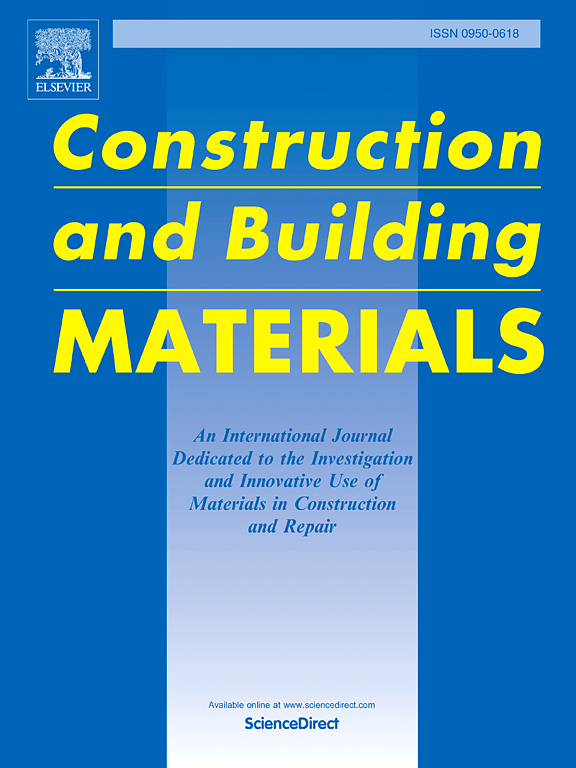Bond-slip behaviour of CFRP-timber joints: The role of strip width, length, and anchor in historical and new wood
IF 8
1区 工程技术
Q1 CONSTRUCTION & BUILDING TECHNOLOGY
引用次数: 0
Abstract
The bond-slip behaviour between carbon fibre reinforced polymer (CFRP) and timber plays a crucial role in the structural performance of strengthened wood elements. This study investigates the bond-slip characteristics of CFRP–timber interfaces by evaluating the effects of wood type, CFRP strip width, strip length, and fan-type anchor arrangements, where mechanical anchors with radially expanding ends are used to improve the bonding performance. Single-lap shear tests were conducted on both historical (old) and newly sourced wood to determine the influence of material properties on bond strength and load transfer mechanisms. Digital Image Correlation (DIC) was utilized to capture full-field displacement and strain distributions along the bond interface, providing a detailed assessment of debonding mechanisms. Additionally, an analytical study was conducted to develop generalized equations for the proposed bond-slip model, offering a comprehensive understanding of interface behaviour. The results indicate that strip width has a more pronounced impact on bond performance compared to strip length, significantly increasing load-carrying capacity and energy absorption. Anchor implementation effectively delays debonding and enhances bond performance, with increasing anchor rows and columns improving stiffness and load resistance. However, beyond a certain threshold, excessive anchoring slightly reduces energy dissipation due to constrained deformation capacity. These findings highlight the necessity of optimizing CFRP strengthening configurations to maximize structural efficiency while maintaining a balance between strength, stiffness, and ductility. The insights obtained contribute to the development of more effective reinforcement strategies for both modern and heritage timber structures.
cfrp -木材接缝的粘结滑移行为:条带宽度,长度和锚在历史和新木材中的作用
碳纤维增强聚合物(CFRP)与木材之间的粘结滑移行为对增强木材构件的结构性能起着至关重要的作用。本研究通过评估木材类型、CFRP条宽度、条长度和扇形锚杆布置的影响来研究CFRP -木材界面的粘结滑移特性,其中使用具有径向扩展末端的机械锚杆来提高粘结性能。对历史(旧)和新来源的木材进行了单圈剪切试验,以确定材料特性对粘结强度和荷载传递机制的影响。利用数字图像相关(DIC)捕获沿键界面的全场位移和应变分布,提供了对脱粘机制的详细评估。此外,还进行了一项分析研究,为提出的粘结滑移模型建立了广义方程,从而对界面行为有了全面的了解。结果表明,与条带长度相比,条带宽度对键合性能的影响更为显著,显著提高了承载能力和能量吸收。锚固装置有效地延缓了脱粘,提高了粘结性能,增加了锚固排和锚固柱,提高了刚度和抗载荷能力。但超过一定阈值后,由于约束变形能力,过度锚固会略微降低能量耗散。这些发现强调了优化碳纤维增强配置的必要性,以最大限度地提高结构效率,同时保持强度、刚度和延性之间的平衡。所获得的见解有助于为现代和传统木结构开发更有效的加固策略。
本文章由计算机程序翻译,如有差异,请以英文原文为准。
求助全文
约1分钟内获得全文
求助全文
来源期刊

Construction and Building Materials
工程技术-材料科学:综合
CiteScore
13.80
自引率
21.60%
发文量
3632
审稿时长
82 days
期刊介绍:
Construction and Building Materials offers an international platform for sharing innovative and original research and development in the realm of construction and building materials, along with their practical applications in new projects and repair practices. The journal publishes a diverse array of pioneering research and application papers, detailing laboratory investigations and, to a limited extent, numerical analyses or reports on full-scale projects. Multi-part papers are discouraged.
Additionally, Construction and Building Materials features comprehensive case studies and insightful review articles that contribute to new insights in the field. Our focus is on papers related to construction materials, excluding those on structural engineering, geotechnics, and unbound highway layers. Covered materials and technologies encompass cement, concrete reinforcement, bricks and mortars, additives, corrosion technology, ceramics, timber, steel, polymers, glass fibers, recycled materials, bamboo, rammed earth, non-conventional building materials, bituminous materials, and applications in railway materials.
 求助内容:
求助内容: 应助结果提醒方式:
应助结果提醒方式:


